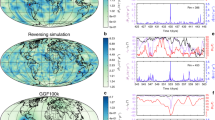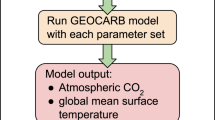Abstract
HYPOTHESES concerning changes in the internal component of the geomagnetic field and consequent effects on climate1–10 are usually based on palaeomagnetic and palaeoclimatic data. Results are often ambiguous due to poor temporal and spatial resolution and difficulties in interpreting the proxy data10–12. Use of historic data partially avoids these problems. Thus, Wollin et al.13 tentatively conclude “that the trends in intensity from most of the magnetic observatories in the world with records over at least 30 yr correlate negatively with the 10-yr means of air temperature”. Because temperature and magnetic field intensity both have regional characteristics, this conclusion implies that the relationship is a local phenomenon although it will be valid globally. This further suggests that the relationship is causal. Wollin et al. presented graphs of mean annual magnetic intensities from 16 magnetic observatories along with 10-yr mean temperatures from nearby meteorological stations; one example is given using a 10-yr running average of winter temperatures and five examples use annual temperatures. Although the graphical data are suggestive of the proposed relationship, the study suffers in three respects. First, data from only 22 of the 43 magnetic observatories listed are presented. Second, the use of 10-yr temperature means yields only three or four data points which may not properly represent the trend of the temperature data. Third, the degree of correlation is not quantitatively evaluated. Here we present statistical evidence that there is no globally valid inverse relationship between geomagnetic intensity and climate for the period covered by observatory records.
This is a preview of subscription content, access via your institution
Access options
Subscribe to this journal
Receive 51 print issues and online access
$199.00 per year
only $3.90 per issue
Buy this article
- Purchase on Springer Link
- Instant access to full article PDF
Prices may be subject to local taxes which are calculated during checkout
Similar content being viewed by others
References
Harrison, C. G. A. & Prospero, J. M. Nature 250, 563–565 (1974).
Reid, G. C., Isaksen, I. S. A., Holzer, T. E. & Crutzen, P. J. Nature 259, 177–179 (1976).
Fairbridge, R. A. Nature 265, 430–431 (1977).
Wollin, G., Ericson, D. B., Ryan, W. B. F. & Foster, J. H. Earth planet. sci. Lett. 12, 175–183 (1971).
Wollin, G., Ericson, D. B. & Ryan, W. B. F. Nature 232, 549–551 (1971).
Harrison, C. G. A. Earth sci. Rev. 10, 1–36 (1974).
Bucha, V. Studia geophys. geod. 20, 149–167 (1976).
Bucha, V. Studia geophys. geod. 20, 347–365 (1976).
King, J. W. Nature 247, 131–134 (1974).
Chiu, Y. T. Nature 250, 642–643 (1974).
Amerigian, C. Earth planet, sci. Lett. 21, 321–326 (1974).
Verosub, K. L. Rev. Geophys. Space Phys. 15, 129–143 (1977).
Wollin, G., Kukla, G. J., Ericson, D. B., Ryan, W. B. F. & Wollin, J. Nature 242, 34–37 (1973).
World Data Center A for Solar-Terrestrial Physics (National Oceanic and Atmospheric Administration, Boulder, Colorado).
U.S. Weather Bureau, World Weather Records, 1942–1950; World Weather Records, 1951–1960; World Meteorological Organization and US Weather Bureau, Monthly Climatic Data for the World, 1960–1974, Vols 13–27 (Department of Commerce, Washington, D.C.).
Fisher, R. A. Statistical Methods for Research Workers, 175–210 (Oliver and Boyd, Edinburgh, 1950).
Tippett, L. H. C. The Methods of Statistics, 249–258 (Williams and Northgate, London, 1952).
David, F. N. Tables of the Ordinates and Probability Integral of the Distribution of the Correlation Coefficient in Small Samples (Cambridge University Press, 1938).
Roberts, W. O. & Olson, R. H. Rev. Geophys. Space Phys. 11, 731–740 (1973).
Author information
Authors and Affiliations
Rights and permissions
About this article
Cite this article
STERNBERG, R., DAMON, P. Re-evaluation of possible historical relationship between magnetic intensity and climate. Nature 278, 36–38 (1979). https://doi.org/10.1038/278036a0
Received:
Accepted:
Published:
Issue Date:
DOI: https://doi.org/10.1038/278036a0
This article is cited by
Comments
By submitting a comment you agree to abide by our Terms and Community Guidelines. If you find something abusive or that does not comply with our terms or guidelines please flag it as inappropriate.



